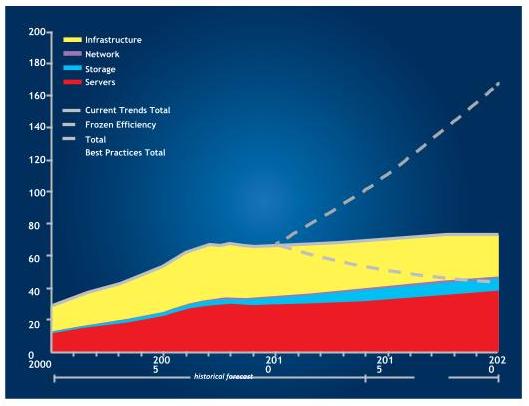
What do CIOs need to know about the changing profile of data center energy usage? And what role should IT leadership play in holding the line on expenses without reducing operating efficiencies?
Data center energy usage is dominated by servers and other infrastructure. But growing energy consumption by storage is also a concern. Estimates put the total data center power consumption in 2020 for the USA to be 73 billion kilowatt hours (kWh).
According to Brad Johns, President of Brad Johns Consulting, data centers consume 1.8% of all electricity in the United States. Servers consume the most power, followed by infrastructure, then data storage –Hard Disk Drives (HDD) and Solid State Disk (SSD) – followed by networking.
And while infrastructure’s power usage has leveled off over the past five years, storage energy consumption has edged upward.
Big Tech responds.
Those figures have put data center energy usage under the microscope from Greenpeace and other environmental bodies. Mega-enterprises with deep pockets are responding aggressively with various plans to reduce carbon emissions generated by their products, production, and supply chains.
Microsoft announced a “Transform to Net Zero” initiative. Amazon invested $2 billion for sustainable technology development to achieve net-zero carbon by 2040. Verizon added a billion to the pot as part of its plans to be carbon neutral by 2035. Walmart, Delta Airlines, and others have followed suit with similar announcements and investments.
Data center energy efficiency is on the rise.
Meanwhile, data center efficiency has soared over the past two decades. Data center power consumption soared by 90% between 2000 and 2005 period. But the rate of growth slowed to only 24% in the following five years, and down to 5% for the 2010-2020 decade. That’s quite an accomplishment over the last 15 years when you consider the rapid expansion of compute power, multi-core processors, cloud computing, analytics, the Internet of Things (IoT), streaming video, virtualization, social media, big data, and telecom bandwidth during this period.
Advances in Power Usage Effectiveness (PUE) have certainly helped. PUE is a ratio of total data center power consumption divided by the power usage by servers, storage, and other equipment. In the past, PUE was typically 2 or higher due to heavy requirements for cooling (PUE of 2 means that for every watt of energy used on equipment, another watt is consumed by cooling and other components).
The good news is that more and more data centers are pushing their PUE scores below 2.
What can CIOs do?
Data center managers, CIOs, IT managers can bring energy consumption under better control by:
Implementing higher efficiency systems – Generally speaking, the more modern the equipment, the higher its efficiency. Just like refrigerators of today are far more energy efficient than those of a decade ago, IT equipment tends to follow a similar trajectory. But check the specs before you buy.
Improving power management – Sophisticated power management systems are now available to isolate areas of wastage and offer ways to consolidate power and cooling loads to improve efficiency.
Streamlining data center design – I visited a data center in Denmark a few years ago that had large concrete beams running the length of the facility. The cooling systems were pointed perpendicular to those beams, thus blocking the flow of colder air from cooling the hot spots above the equipment racks and raising the overall power usage in the facility. The lesson is clear: Those with older facilities should review existing designs and equipment placement and adjust for better efficiency. New data centers should closely follow current best practices, particularly those employed by the likes of Google, Amazon, Switch and other major data centers.
Moving inactive data to tape – This will lower both data center energy usage and costs. Tape media can be stored off-line, further reducing energy usage. With storage consuming 19% of overall data center power, and upwards of 60% of that data rarely accessed, according to the Tape Storage Council, keeping such data on spinning disk is a serious area of overall energy wastage in IT.
With the growth of edge computing and data storage, individual businesses may ultimately see their data center energy expenses drop. But CIOs have a key role to play in reducing energy demand by cultivating continuous innovation and best practices from their data centers, whether they’re across town or on the other side of the world.
